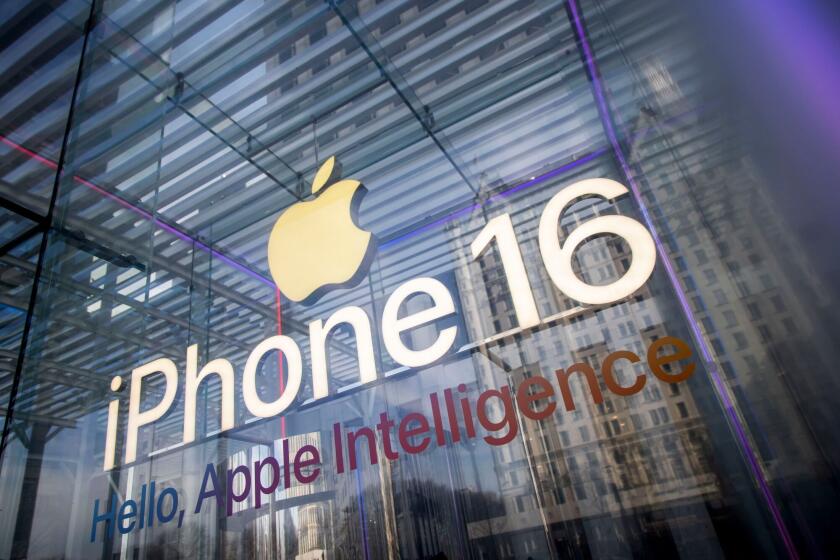Entrepreneur Gets Rich Quick : Publishing: After the magazine’s death was widely predicted, circulation rose 82% between 1987-90. Focus was the key, editors say.
- Share via
IRVINE — The folks at Entrepreneur magazine are eager to say they told you so.
Chief executive Peter Shea, a man with polished manners and Johnny Carson looks, says it’s now clear that doomsaying magazine analysts overreacted to problems his company faced last spring.
The Irvine-based publication had trouble paying its bills, was laying off employees and looking for a partner to bail it out.
Now, publisher Jim Fitzpatrick can even laugh about the time the owner of a now-defunct rival magazine allegedly called Entrepreneur a “rag.”
In this, the great shakeout after the 1980s magazine boom, it is Entrepreneur’s turn to gloat. Why? In 1987-90, its circulation increased 82%, to 325,000, and total advertising pages jumped a strong 178%, to 2,002. The growth is continuing this year.
For the second consecutive year, the advertising trade magazine Adweek has placed Entrepreneur on its list of top 10 hottest magazines, an honor bestowed by a panel of experts that takes into account ad pages and revenue.
Other winners were big-name magazines such as the Economist, the Atlantic and Parenting.
Fitzpatrick is betting Entrepreneur can make Adweek’s list again for 1991. With 25 new national advertisers in two years--including Apple Computer, AT&T; and American Express--the publishing company’s ad revenue was up 39% in 1990, to $19.7 million, and revenue increased nearly 69% the year before.
Industry analysts say Entrepreneur, which costs $3 at the newsstand, is succeeding because it brings solid how-to information to small-business owners, generally those with fewer than 20 employees. It is a growing niche that no other magazine is reaching. The magazine’s nearest competitor, Success, prints features about business people who have triumphed but conveys little information about the process of running a business.
Entrepreneur’s transformation has been one of image as much as ad dollars. In the April issue of Entrepreneur, editor-in-chief Rieva Lesonsky said the magazine that once was an ugly duckling has become a swan.
“Entrepreneur is now one of the nation’s leading magazines,” Lesonsky boasted in her monthly column to readers. “We were (in the past) a small, basically unattractive magazine filled with unfocused, often self-serving articles.”
The publishing company, Entrepreneur Group Inc., has branched out with two other monthly magazines: Entrepreneurial Woman, which debuted as a bimonthly with the March/April, 1990, issue; and New Business Opportunities, first published in February, 1989.
Even Entrepreneur’s peers--the second-tier business magazines a notch below Business Week, Forbes and Fortune--have begun to take notice.
“There was a time when we didn’t pay much attention” to Entrepreneur, said George Gendron, editor-in-chief of Inc. magazine, a Boston-based monthly that, while on the same tier, does not compete directly with Entrepreneur. “In the past 18 months, their editorial (content) has begun to gel; there’s a nice focus. Lack of focus is the kiss of death.”
Entrepreneur’s focus is still largely soft. The May cover story was a thinly veiled promotion of cellular phones, facsimile machines and laptop computers--the kind of story advertisers are sure to love.
But the issue also included other interesting and useful information: One feature tells about four businesses that are selling ethnic products, from Scottish kilts to Russian literature. Another story describes the basics of great customer support.
Publishing analysts have no doubt that Entrepreneur’s fortunes will continue to rise. The magazine has chosen an untapped market to serve: new businesses--especially franchises--with fewer than two dozen employees.
In this recession, small and start-up businesses are growing while many large companies are downsizing. The franchise market is expected to sell more than $758 billion in goods and services this year, according to the International Franchise Assn. in Washington. And small businesses buy 85% of all office switchboard equipment and more than half of all copiers, telephones, fax machines and personal computers.
“The magazine’s success is the economy,” said George Hayes, director of media planning for New York-based ad agency McCann-Erickson. “Whether you’re out of work or think you’re about to be, the thought of having your own business probably appeals to you. For advertisers, it’s an opportunity to reach somebody who still has some cash.
“Entrepreneur may be in the right place at the right time, which is 90% of success.”
Drivers heading north past Irvine on the San Diego Freeway may know Entrepreneur best for the huge red letters that spell out the magazine’s name on the side of its low-lying building. Inside, 3-foot-tall reproductions of magazine covers are framed along every hall of the magazine’s offices.
On a recent Friday morning, Shea and Fitzpatrick were dressed in khaki pants and bright plaid shirts--Friday, Shea explained, is their day to dress down--and the two were meeting Lesonsky at noon to walk down to the Irvine Sports Club to work out.
Lesonsky said she likes the camaraderie, but she makes it clear that, like most people who work together, they have their differences: “We don’t skip along the hallways together.”
That day Lesonsky was planning Entrepreneur’s July issue, which will be more than 300 pages thick and is filled with ads for franchise opportunities, office supplies, software and computer training sessions, with a growing number of national ads for cars and computers. The magazine says its average reader is 39, male, owns a home, attended college, works as a manager and has a household income of $60,100. More than 34% own their own business.
Appealing to a more blue-collar audience is New Business Opportunities, with its ads saying, “How to Get Rich” and “Big profit (in) import mail order business.” It has been profitable since its first issue, Fitzpatrick said. He would not reveal the magazine’s current revenue.
Profitability has eluded Entrepreneurial Woman. Shea said advertisers are wary of the magazine because it is not yet a year old. The company expects a high subscription renewal rate in September.
If the prediction proves true, Shea said, salespeople will try to use that affirmation to sell advertising for the magazine more aggressively this fall.
Fifty percent of the Entrepreneur Group’s revenue--which Shea said will reach $30 million this year--comes from ad sales. Another 20% of revenue is from the sale of how-to manuals, which are written by the magazine staff and explain how to set up a business. The manuals retail for $69.95 each. The remaining 30% of revenue comes from subscriptions, newsstand sales and the sale of subscriber lists. Fitzpatrick, the publisher, said the company is profitable, but he would not disclose its net income.
The library of manuals numbers almost 250. Writers are working on two new manuals: How to become a recycling consultant, and how to provide language and cultural translation services for businesses planning to enter the European market.
The recycling consultant idea is so new, Lesonsky said, that she and her staff had to invent the name.
The how-to manuals, however, hark back to Entrepreneur’s earliest days.
In 1973, Chase Revel started printing manuals on how to get started in small business through his Chase Revel Inc., a Los Angeles company. Revel soon began publishing a magazine called Entrepreneur, as well. Its theme was similar to today’s New Business Opportunities: get-rich-quick formulas for the common man.
With a downturn in the economy, Revel filed for bankruptcy in 1982. The magazine later became the property of a public company. A palimony suit filed against Revel in July, 1985, revealed that Revel was an alias and that he had been convicted of bank robberies under his given name of John Leonard Burke in Las Vegas and Houston about 20 years earlier.
“That’s what they were up against when I was first hired” in 1986, said Gayle Sato Stodder, who now writes a monthly small-business column for Entrepreneur. “They were trying to establish themselves as a good new business magazine, with that founder in mind.”
Shea is an unlikely publisher. In 1972, he co-founded Irvine-based Gradco Systems Inc., an office equipment supplier, and later sold his share in the company. In 1983, he and partners bought Stained Glass Overlay Inc., an Irvine-based company that pastes colored film to regular windowpanes to give them a stained-glass look. Stained Glass Overlay, which has sold more than 300 franchises, was one of Entrepreneur’s biggest advertisers, with a full-page ad each month. In January, 1987, Shea and his two partners, Barry Rupp and Reinhold Pfahler, paid $3.5 million for about two-thirds of the magazine company’s stock.
“We were kind of like the Remington Razor guy,” Shea said. “We liked the company so much, we ended up buying it.”
The new owners decided that Entrepreneur, which was created as a guide to starting a business, had built in an obsolescence for itself: Once a business was started, people no longer needed to read the magazine. So they refocused so it would also appeal to people who already owned a business for perhaps three to five years.
In February, 1988, the magazine moved its offices from West Los Angeles to Irvine. Within a year, it had added marketing staff in New York, Detroit and Chicago.
Shea has since bought out his partners in the magazine, which became a private company again in April, 1989. His stained-glass company now shares an office with Entrepreneur.
Fitzpatrick, who directed marketing for Stained Glass Overlay, moved into the magazine business with Shea. He said the key to Entrepreneur’s success is that it holds fast to its identity.
“Some magazines try to become all things to all people,” he said. “They see a downturn (in the economy), and they try to broaden their base” to capture more advertisers.
He said Venture magazine, which recently stopped publication, is a prime example. The magazine lost its focus on venture capitalists and mid-size businesses. In one issue, Venture featured a surfboard maker on the cover and placed a Rolls-Royce ad just inside.
“Identity takes discipline, but it’s essential,” Fitzpatrick said.
The magazine field is strewn with publications that have disappeared in the past two years--Venture, Business Month, New England Monthly and Woodland Hills-based Moxie among them.
Just one year ago, Entrepreneur looked as if it too might be heading for the magazine graveyard. Newspaper reports announced that the magazine’s aggressive expansion had resulted in more than $1 million in unpaid bills to a printer, a media buyer and a paper supplier.
Shea acknowledged then that he was behind in his bills and said he was talking to foreign publishers about investing in the magazine.
A week later, publisher Clare Thain resigned, citing a disagreement over “the direction the magazine was taking,” and seven people were laid off from marketing and clerical positions, leaving a full-time staff of 61.
“The reality was, we grew faster than our cash flow,” Shea said during a recent interview. “We resolved that. Our cash flow problems were not as horrendous as reported.”
“We were fortunate to have made the cutbacks we made when we did,” Fitzpatrick added. “A lot of magazines are now doing the cost-cutting things we did a year ago.”
But if doing business in America is tougher than usual these days, you might not know it reading the pages of Entrepreneur. While the magazine offers useful advice--such as a description of federal tax subsidies available for overseas expansion, and 10 ways to cut on-line computer costs--most of the magazine strikes a note of false enthusiasm. It’s almost like the company president who raves about improved sales--while signing this week’s pink slips.
For example, a story about a security alarm maker described him as “restless, ambitious and compulsive” with “a feel for business and an unquenchable sense of adventure” in one short paragraph. His previous bankruptcy, at age 29, is dealt with cursorily: “He was too young to throw in the towel, his spirit was intact and he was more determined than ever to get back on his feet.”
If a profile subject’s story is too sad, said Sato, the small-business columnist, the story usually does not find its way onto Entrepreneur’s pages.
Lesonsky, who started as a research assistant with the magazine in 1978, said the upbeat tone is exactly what she is striving for. “We’re not a news magazine,” she said. “We’re not Business Week; we’re not out to expose anything.
“We’re out to tell you how to better run your business, and so much of business is psychology. Well, we’re here to help you with that.”
Inc. magazine’s editor, Gendron, disagreed with that mission. “You have to be kind of careful with people who don’t have companies and are thinking about” starting them, he said. “The worst thing you can do is deceive them into thinking it’s easy.”
Small-Business Magazines Are Big Business
Entrepreneur has moved steadily upward in the ranks of business magazines over the past five years by focusing on new businesses, franchise opportunities and small firms with 20 or fewer employees. It was alone among the seven top business magazines to report an increase in ad revenue in the first five months of 1991. A sister publication, Entrepreneurial Woman, also reported a sizable gain.
1991 Rankings Advertising 1990-91 (Jan.-May) Revenue Pct. Change 1. Business Week $75.9 -16.5% 2. Forbes $59.1 -15.1% 3. Fortune $48.3 -18.5% 4. Inc. $15.8 -11.6% 5. Entrepreneur $9.3 14.6% 6. Economist $8.7 -9.2% 7. Financial World $8.2 42.8% 8. Black Enterprise $4.6 3.0% 9. Nation’s Business $4.3 3.8% 10. Success $3.2 12.1% 11. Harvard Business Review $2.5 -3.6% 12. Corporate Finance $1.5 -10.6% 13. Entrepreneurial Woman $1.0 31.9%
COMPETING FOR SMALL-BUSINESS ADVERTISERS
In millions of dollars, rounded off to the nearest hundred-thousand.
ENTREPRENEUR Advertising 1990-91 Revenue Pct. Change 1991 (Jan.-May) $9.3 14.6% 1990 $19.7 38.9% 1989* $14.2 14.6% 1988** $5.8 * 1987 * * 1986 * * 1985 * *
INC. Advertising 1990-91 Revenue Pct. Change 1991 (Jan.-May) $15.5 11.6% 1990 $48.1 3.1% 1989 $46.6 10.5% 1988 $42.2 8.9% 1987 $38.8 23.9% 1986 $31.1 -2.4% 1985 $32.1 -8.4*
SUCCESS Advertising 1990-91 Revenue Pct. Change 1991 (Jan.-May) $3.2 12.1% 1990 $7.8 -0.3% 1989 $7.8 46.5% 1988 $5.3 9.1% 1987 $4.9 14.1% 1986 $4.3 23.8% 1985 $3.4 20.1%
VENTURE Advertising 1990-91 Revenue Pct. Change 1991 (Jan.-May) * * 1990 * * 1989 * * 1988 $14.8 -4.0% 1987 $15.5 25.2% 1986 $12.4 7.6% 1985 $11.5 6.8%
Venture magazine folded in 1989. * First time on national ranking list where ad revenue figures were audited. ** First year of the newly-revamped Entrepreneur magazine; ad revenues not audited by PIB. (Figures were provided by Adweek magazine.) Researched by DALLAS M. JACKSON / Los Angeles Times
More to Read
Inside the business of entertainment
The Wide Shot brings you news, analysis and insights on everything from streaming wars to production — and what it all means for the future.
You may occasionally receive promotional content from the Los Angeles Times.










